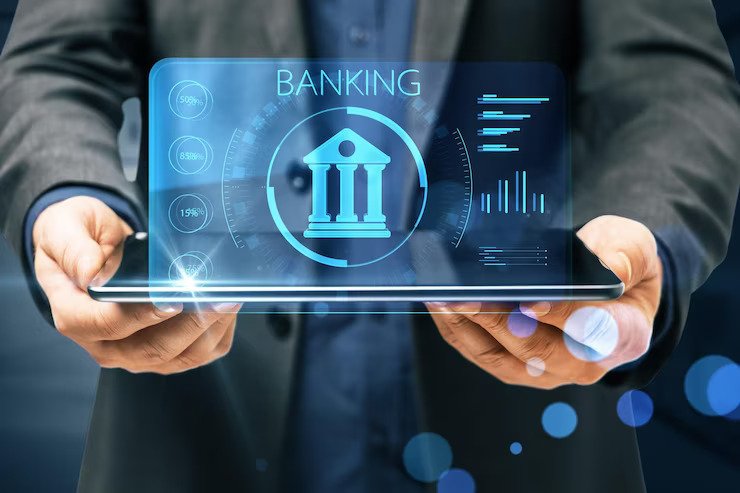- The Evolution of Banking Software
- The Importance of Customer Experience in Banking
- Innovative Banking Software Solutions
- Streamlining Account Management
- Enhancing Mobile Banking Apps
- Personalized Financial Insights
- AI-Powered Customer Support
- Security and Compliance in Banking Software
- Data Analytics for Customer Understanding
- Integration with Fintech Partners
- Conclusion
Innovative Banking Software for Seamless Customer Experiences

Banking has come a long way since the beginning of the 20th century.
Banking software solutions have transformed the way businesses operate and how customers interact with them. Banking software solutions offer increased security, faster transactions, and better customer experience.
In this article, we will go over some of the most innovative banking software solutions to help you increase your business efficiency, engage your customers more effectively, and profitably manage your assets.
The Evolution of Banking Software
Banking software has evolved over time to meet the demands of customers who want more than just a tool for account management and online banking. Today’s banking software solutions are designed to deliver a seamless customer experience across all channels, including mobile, voice, and chat-based interactions.
In addition to these traditional channels, financial institutions have begun exploring additional ways they can engage with their customers through innovative technologies such as virtual reality (VR), augmented reality (AR), or artificial intelligence (AI).
The Importance of Customer Experience in Banking
You may be wondering: What exactly is customer experience? It’s a phrase that gets thrown around a lot, but what does it really mean? In short, customer experience is about how you interact with customers and how they interact with your brand. The overall experience of your customers can be described as a combination of all the interactions they have had with your company from their first interaction until they’ve become an advocate or repeat customer.
Customer experience matters because it’s essential for companies to understand what drives their customers’ decisions, preferences, and behaviors so that they can provide better service and products over time. In fact, according to research from Forrester Consulting Inc., companies that focus on improving their customer experiences see higher levels of profitability than those who don’t invest time or money into these efforts; this includes banks!
Innovative Banking Software Solutions

Banking software is evolving to meet the needs of customers. One way it’s doing this is by improving the customer experience and creating seamless interactions between banks and their clients.
To do this, new technologies are being used that allow banking software to be more personalized and customized for each client. This means that banks can offer personalized products based on the individual needs of their customers, which makes them more likely to buy from them again in the future (or even switch banks).
Streamlining Account Management
Account management is a critical component of the customer experience. It’s not just about opening an account and managing it; it’s also about providing your customers with seamless access to their accounts, which can be accomplished through account management software. With this software, you can automate account opening processes, manage multiple accounts and products in one place, and provide your customers with self-service capabilities.
Enhancing Mobile Banking Apps
Mobile banking apps are the new norm. The vast majority of banks have mobile banking apps, and they’re used on a daily basis by millennials and older generations alike. Mobile banking apps are also used by people with a variety of devices from smartphones to tablets to wearables.
This means that your bank’s mobile app must be able to handle everything from simple tasks like checking balances or transferring funds between accounts, all the way up through more complex services like paying bills or viewing statements online.
Personalized Financial Insights
Personalized insights provide a deeper understanding of your customers’ needs and preferences. They can be used to improve customer satisfaction, create a better user experience, or increase profitability.
Personalized insights are based on individual customer preferences as well as analytics that identify patterns in their behavior. For example:
- If you’re an online retailer and you notice that many people who buy shoes also buy socks; this could indicate that it would be worthwhile for you to offer free shipping on all footwear items (so if someone buys two pairs of shoes and wants free shipping, they get it).
- If someone has been spending most of their time playing games A-C but suddenly starts playing game D instead; this might indicate they’ve become bored with those other games and want something new!
AI-Powered Customer Support
AI-powered customer support is one of the most exciting innovations in banking. It can help you provide more personalized experiences, reduce costs, and improve risk management while also improving compliance.
AI is already being used by banks to automate many aspects of customer service, from answering simple questions to providing more complex advice by gathering data from multiple sources (including social media) and applying it to specific situations or scenarios.
AI has even been used for fraud detection: machine learning algorithms have been programmed with thousands upon thousands of examples of fraudulent transactions which they use as benchmarks for future transactions that could be suspicious or not legitimate and then flag those accounts accordingly!
Related: Top 10 Personal Banking Tips
Security and Compliance in Banking Software

Security and compliance are top priorities for banks. Customers want to know that their data is safe, secure, and protected. They also want to be sure that the bank is following all government regulations regarding privacy and security.
A bank’s software must be able to handle all of these requirements if it wants to provide customers with a seamless experience.
Data Analytics for Customer Understanding
Data analytics is the process of extracting and analyzing data to gain insight. The use of data analytics helps banks understand their customers better, which in turn allows them to design products that meet the needs of various groups within society.
Data analytics can be used in several ways:
- To identify new business opportunities or threats
- To improve operational efficiency (e.g., reducing costs)
- To predict customer behavior based on previous patterns
Integration with Fintech Partners
Integration of banking software with fintech partners is crucial to a seamless customer experience.
Finance technology (fintech) companies specialize in providing innovative solutions for businesses and customers, leveraging their expertise in the latest technologies such as cloud computing, artificial intelligence (AI), machine learning, and blockchain. They offer services ranging from payment gateways to online lending platforms or virtual assistants that help automate tasks in the office environment.
Integrating your banking software with these platforms will enable you to extend your service offerings beyond core banking functions such as deposits/withdrawals and account management while providing additional value-added services through third-party providers at minimal cost to yourself while also allowing customers access multiple digital channels all under one roof without having to switch between multiple apps or websites during each transaction cycle which improves conversion rates while reducing churn rate over time since they don’t have any reason not stay loyal anymore.
Conclusion
Banking software is one of the most essential tools for financial institutions. Banks rely on this technology to manage their operations and serve customers efficiently. With the right banking software, banks can streamline their processes, reduce costs, and offer better customer experiences.
Read Also:










